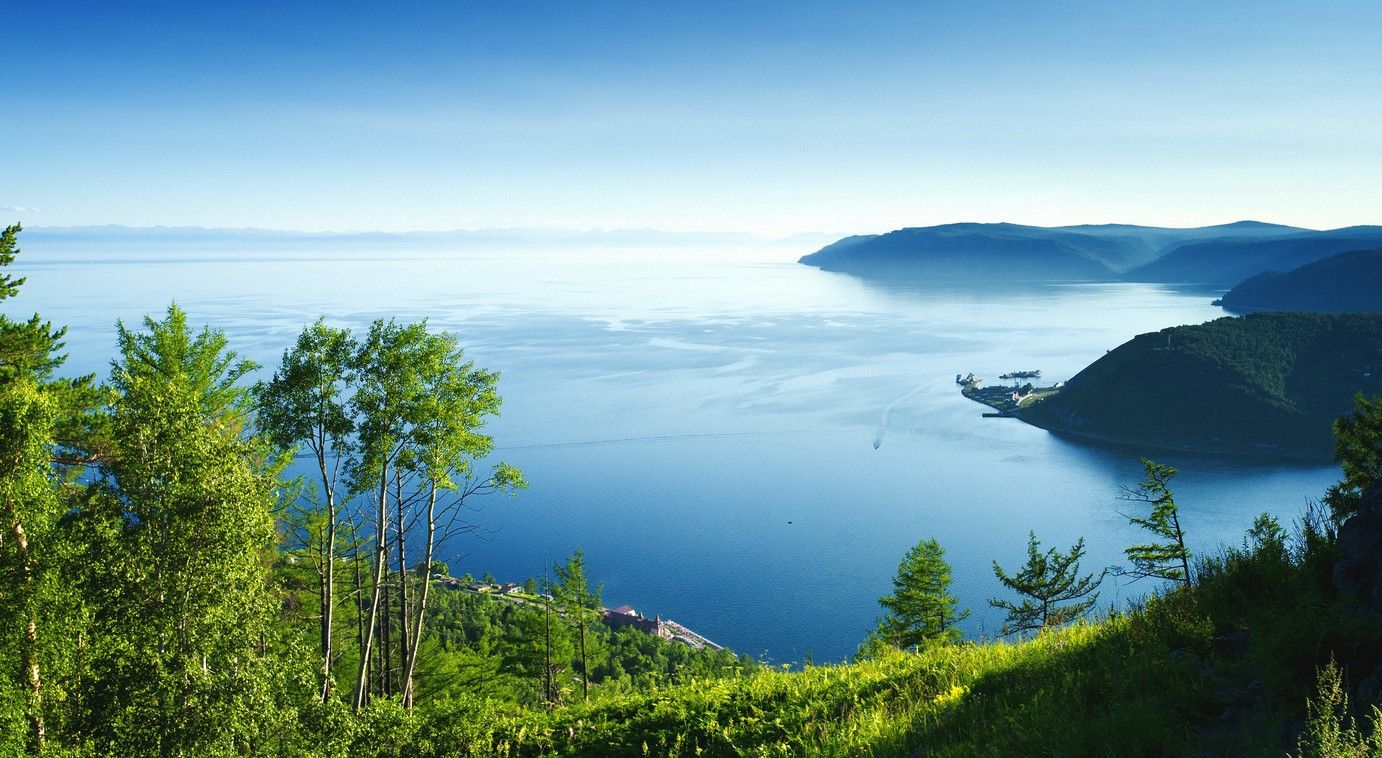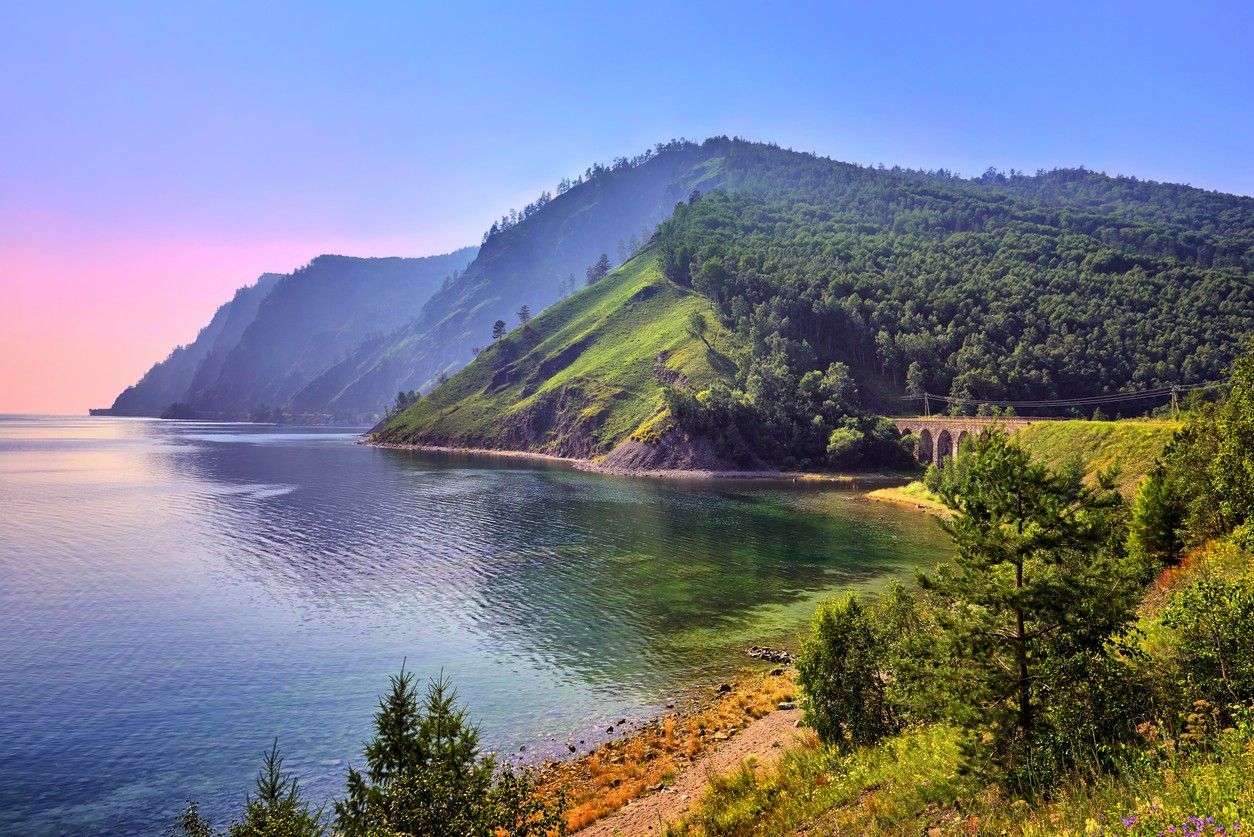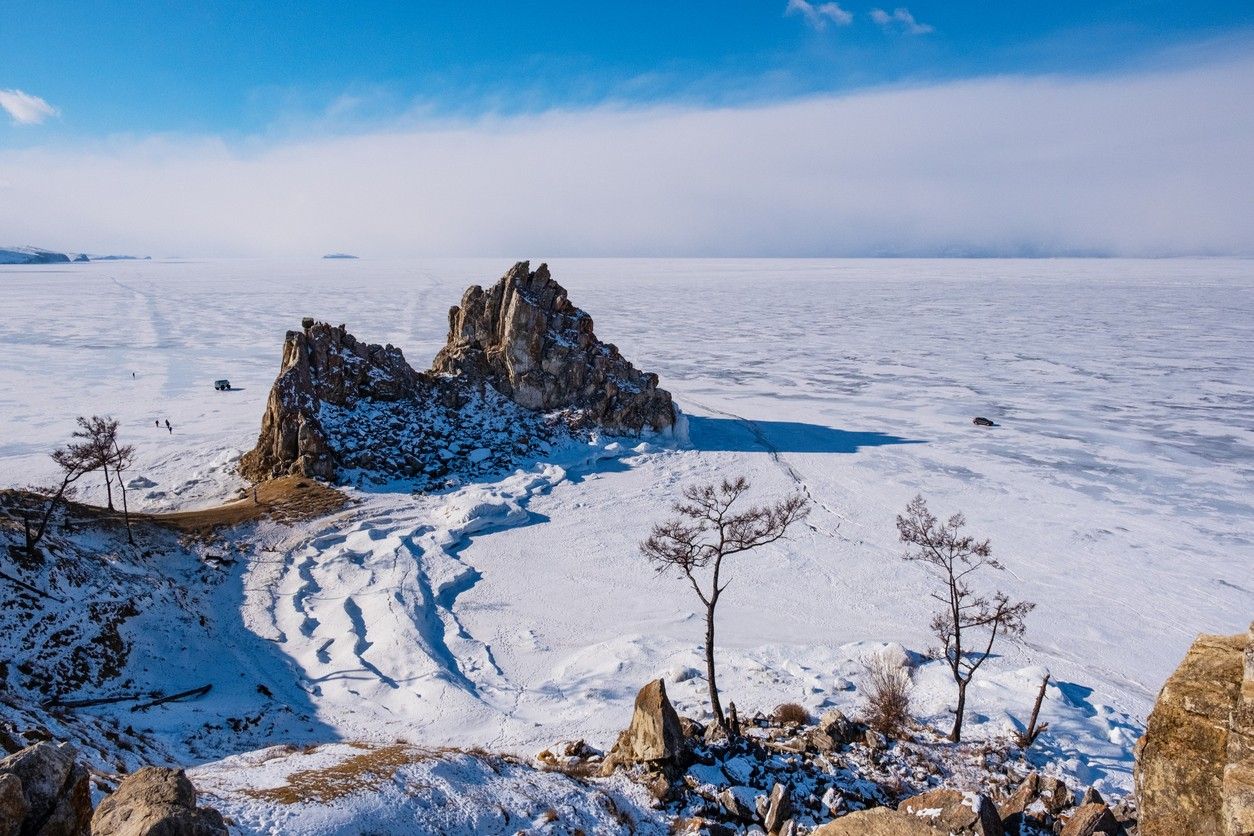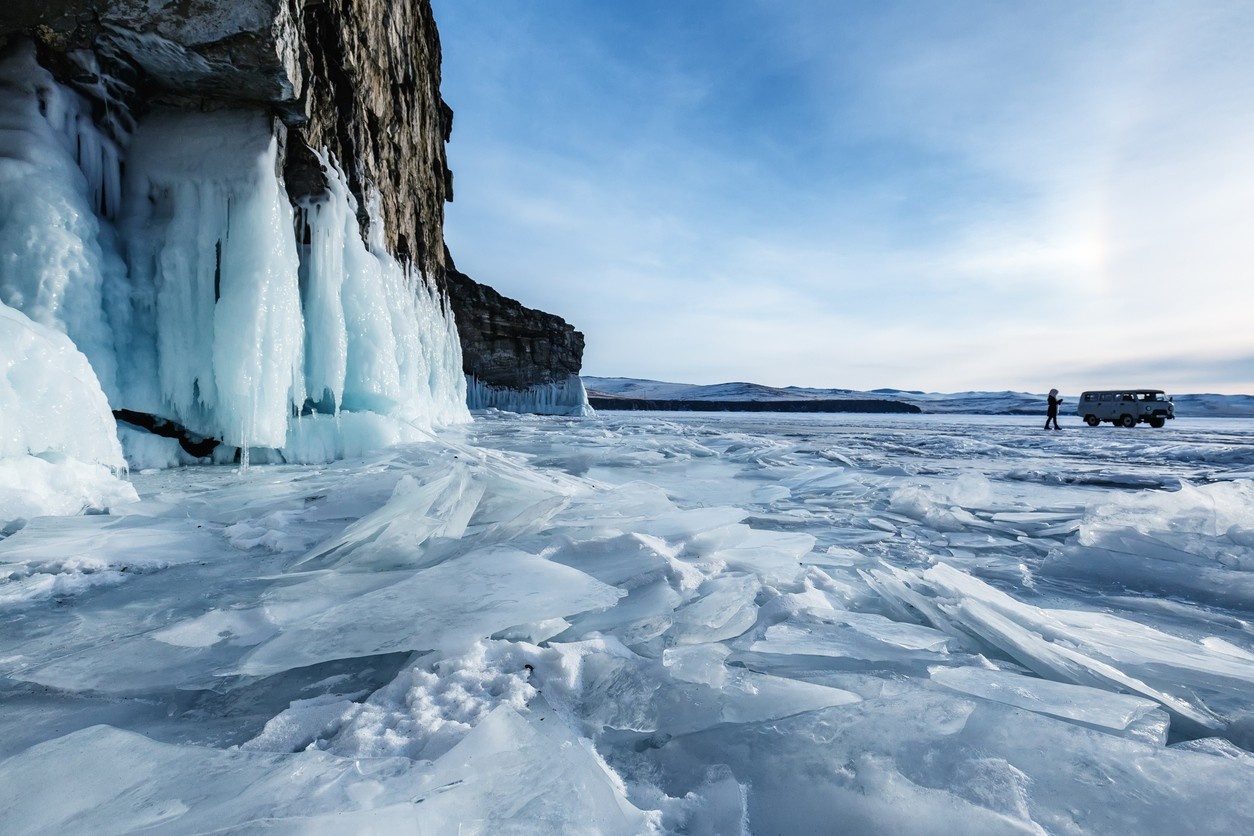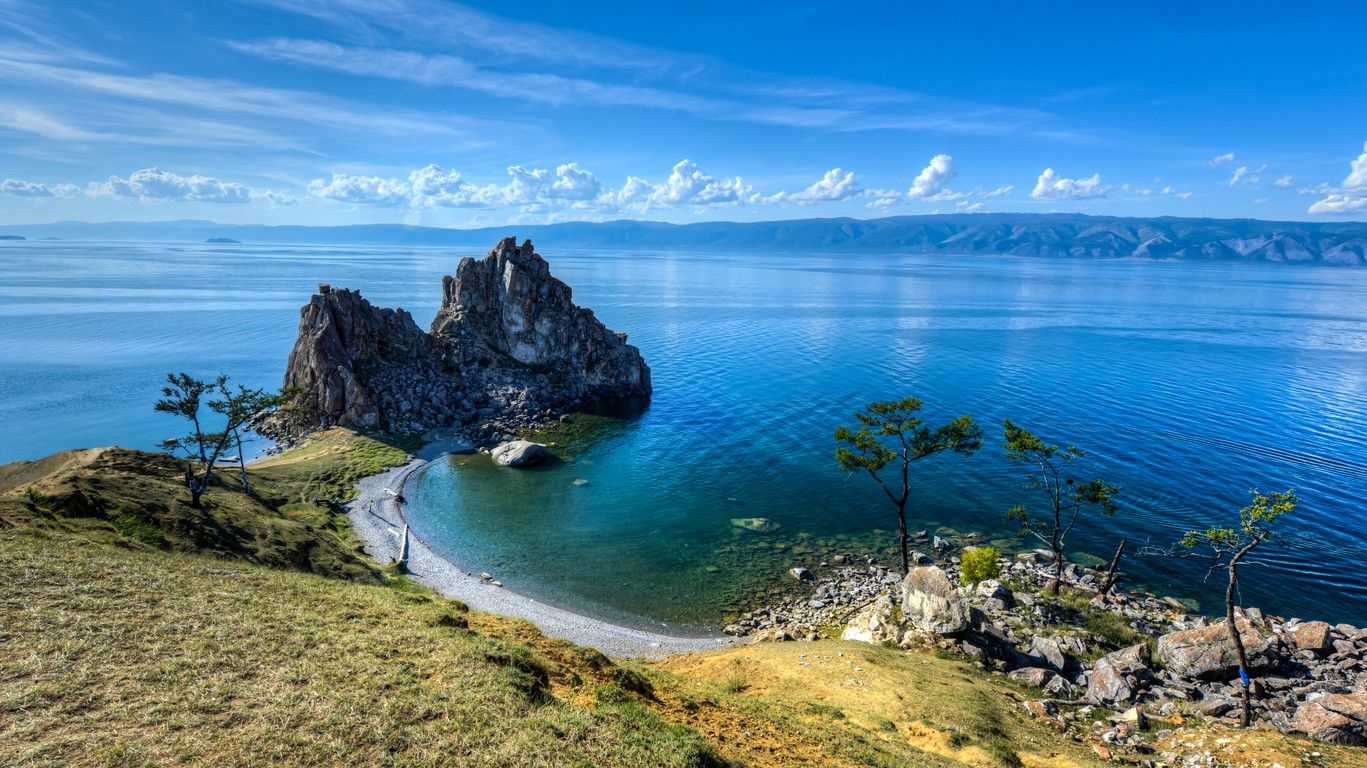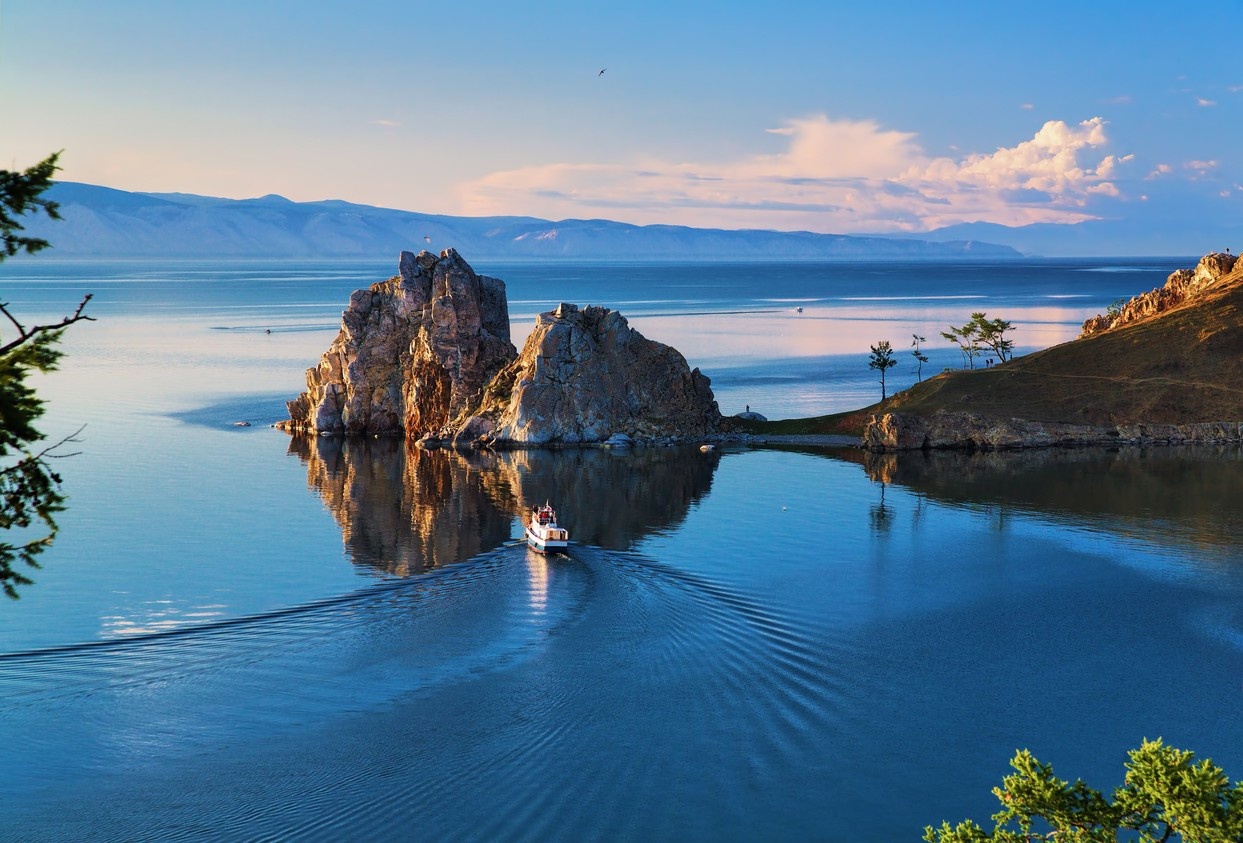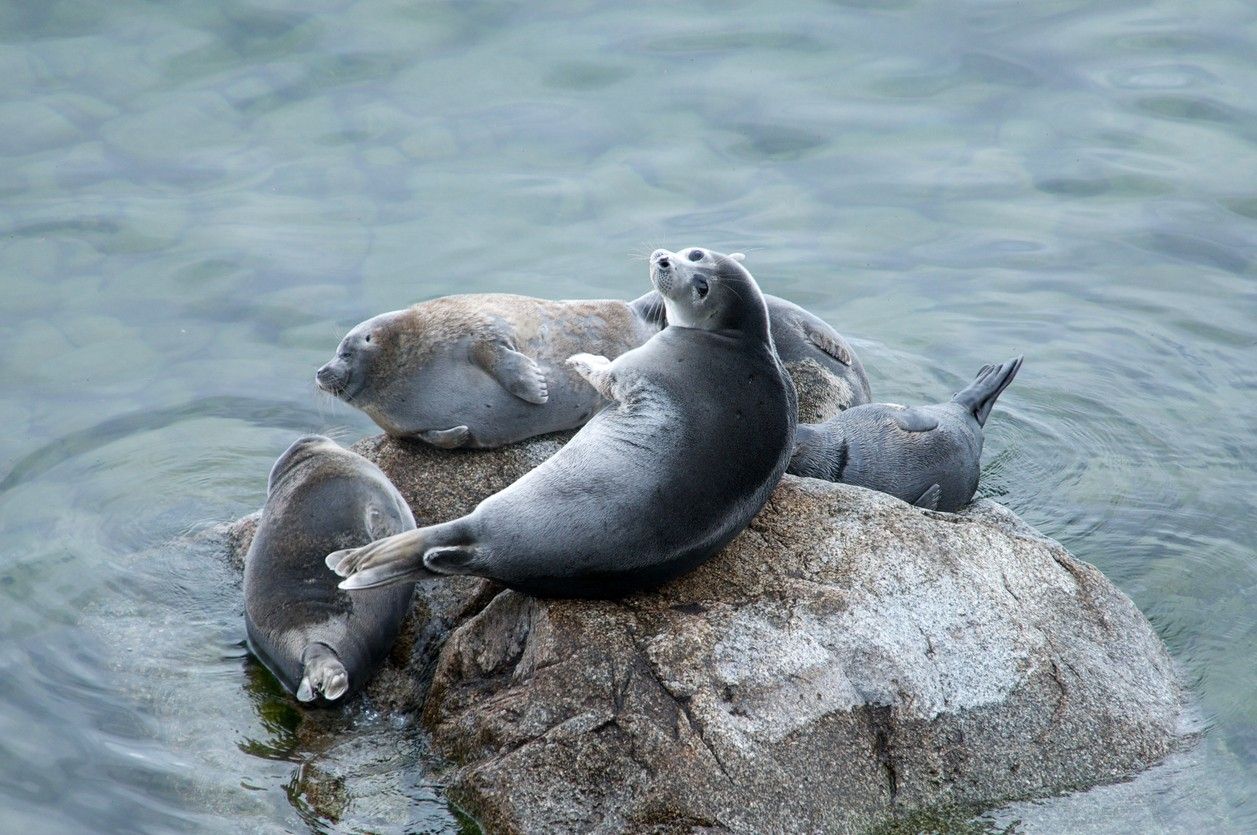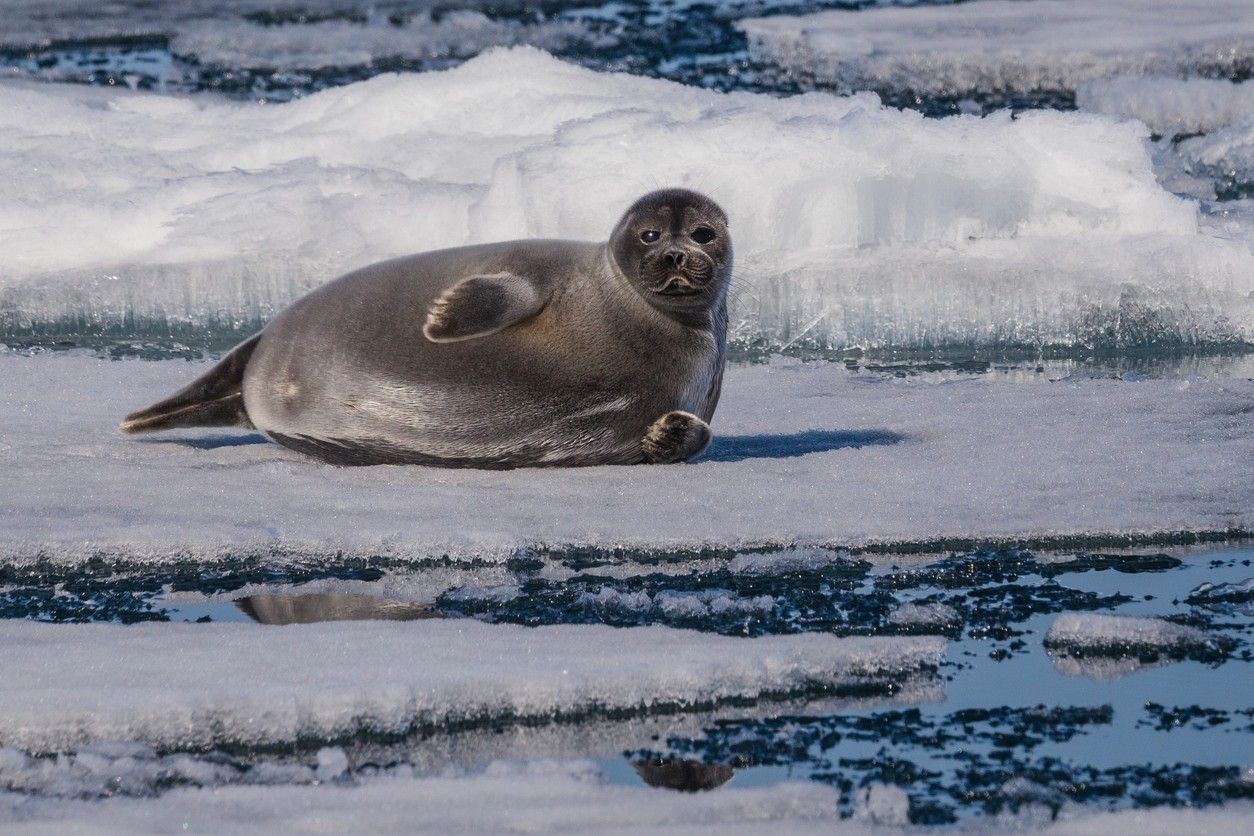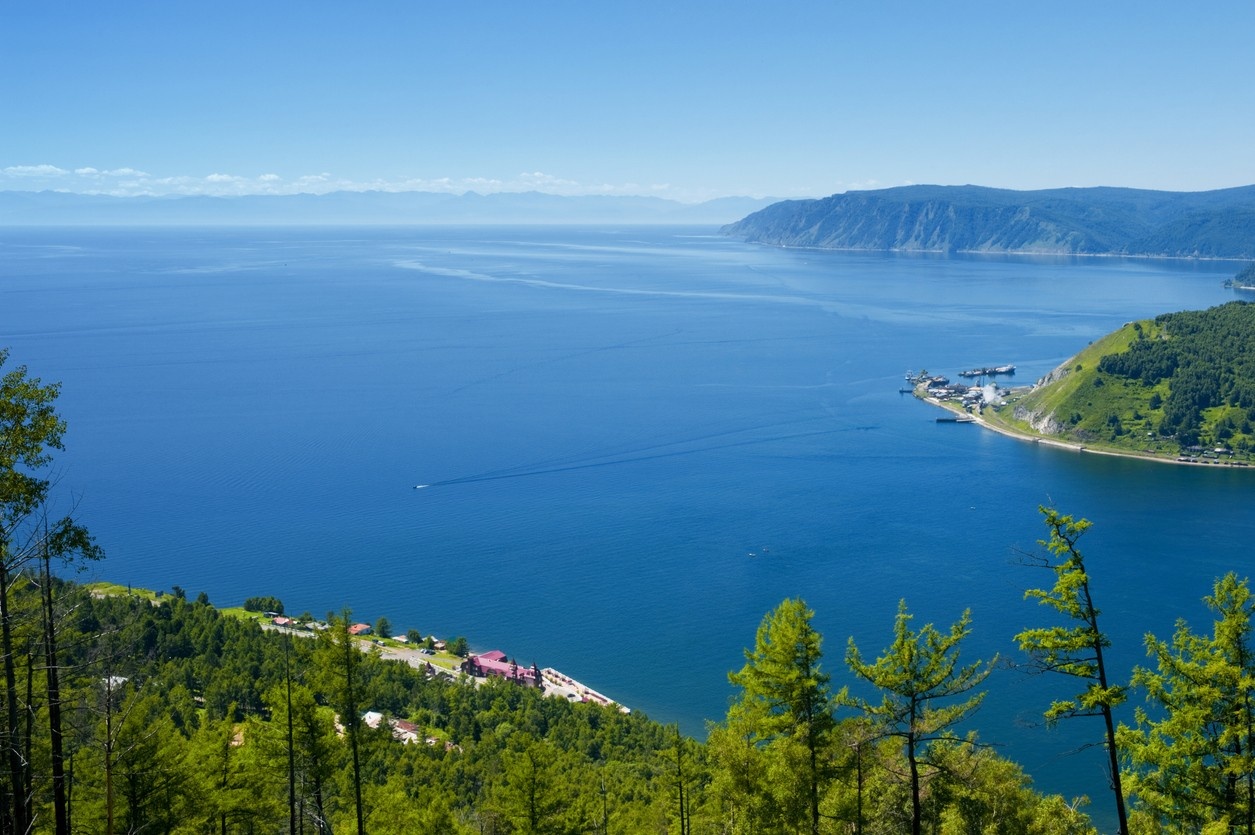Lake Baikal, the oldest and deepest lake in the world, is a natural wonder that attracts visitors from all over the globe. Located in the heart of Siberia, this UNESCO World Heritage site is renowned for its crystal-clear waters, unique ecosystem, and stunning landscapes. But there's more to Lake Baikal than just its natural beauty. The region offers a wide range of activities and experiences that allow visitors to immerse themselves in the local culture, history, and outdoor adventures. From exploring the fascinating exhibits at the Baikal Museum in Listvyanka to hiking up the majestic Chersky Mountain, there's no shortage of things to do and see around Lake Baikal. Whether you're a nature lover, history buff, or adventure seeker, this incredible destination has something to offer everyone.
The Location & Depth of Lake Baikal
Lake Baikal is situated in the southern part of the Russian region of Siberia, near the city of Irkutsk. The lake is located in a rift valley, which was formed by the divergence of the Eurasian Plate and the Amur Plate over 25 million years ago. This tectonic activity has created a long, crescent-shaped lake that stretches for nearly 400 miles (636 km) from north to south and has an average width of about 30 miles (48 km). The lake is surrounded by the Baikal Mountains, which rise to heights of over 6,600 feet (2,000 meters) above the lake's surface. These mountains are covered in dense forests of larch, pine, and birch trees, which provide a stunning backdrop to the lake's crystal-clear waters. The mountains also play a crucial role in the lake's ecosystem, acting as a natural barrier that helps to regulate the lake's temperature and protect it from outside influences. The lake is located in a remote region of Siberia, far from major cities and industrial centres. This isolation has helped to preserve the lake's pristine waters and unique ecosystem, making it one of the most unspoiled natural wonders on the planet. Despite its remote location, Lake Baikal is relatively easy to access. The nearest major city is Irkutsk, which is located about 40 miles (64 km) to the west of the lake. Irkutsk is served by an international airport and is connected to other major cities in Russia by rail and road. From Irkutsk, visitors can reach Lake Baikal by bus, car, or train, with the journey taking anywhere from a few hours to a full day, depending on the mode of transportation and the specific destination on the lake.
One of the most remarkable features of Lake Baikal is its incredible depth. With a maximum depth of 5,387 feet (1,642 meters), it is the deepest lake in the world. To put this into perspective, if you were to place the Eiffel Tower at the bottom of Lake Baikal, its top would still be more than 300 feet (91 meters) below the surface of the water. The immense depth of Lake Baikal is due to its location in a rift valley. Over millions of years, the tectonic plates that form the valley have been slowly pulling apart, creating a deep, narrow basin that has been filled with water. The lake's depth varies considerably from one end to the other, with the northern part of the lake being much shallower than the southern part. The depth of Lake Baikal has a significant impact on its ecosystem. The deep waters of the lake are incredibly clear, with visibility extending up to 130 feet (40 meters) in some areas. This clarity is due in part to the lake's low levels of organic matter and the presence of a unique species of freshwater sponge that filters the water. The deep waters of Lake Baikal also play a crucial role in regulating the lake's temperature. Despite its location in Siberia, where temperatures can drop to -40°F (-40°C) in the winter, the water temperature at the bottom of the lake remains a constant 39°F (4°C) year-round. This stable temperature helps to support a diverse array of plant and animal life, including many species that are found nowhere else on Earth.
Visit the Baikal Museum in Listvyanka
The Baikal Museum, also known as the Limnological Museum, is a must-visit attraction located in the village of Listvyanka on the shores of Lake Baikal. As one of only three museums in the world dedicated solely to a lake, it offers a unique and fascinating insight into the ecology, history, and science of Lake Baikal, the oldest and deepest lake on Earth. The museum has a long history, with its origins dating back to 1928 when it began as a Limnological station. In 1961, it was reorganised into the Limnological Institute of the Siberian branch of the Russian Academy of Science. Today, the Baikal Museum is a popular destination, attracting more than 50,000 visitors annually. The museum's exposition includes regular exhibits showcasing the lake's diverse flora and fauna, as well as aquariums housing Baikal fish, crustaceans, sponges, and the famous Baikal seals (nerpa). These displays allow visitors to get up close to the unique endemic species that inhabit the lake's depths, some of which can be found at depths of up to 1,642 meters. One of the museum's most exciting features is the "interactive submergence" experience. Visitors can embark on a virtual journey to the bottom of Lake Baikal in a simulated submarine, reaching the lake's maximum depth of 1,637 meters and observing the most interesting species along the way. This immersive experience lasts about 15 minutes and provides a life-like glimpse into the mysterious underwater world of Lake Baikal. The Baikal Museum is constantly evolving and expanding, with new exhibitions and exhibits being added regularly to showcase the latest discoveries and research on the lake. Despite being the oldest lake in the world, there are still many unexplored facts and secrets about Lake Baikal waiting to be uncovered. In addition to its scientific and educational value, the Baikal Museum also offers stunning views of Lake Baikal and the surrounding landscape. Its location in Listvyanka, a picturesque village on the lake's western shore, makes it an ideal starting point for exploring the natural wonders of the region. Whether you are a nature lover, science enthusiast, or simply curious about the unique ecosystem of Lake Baikal, a visit to the Baikal Museum in Listvyanka is an unforgettable experience that should not be missed.
Try the local Baikal omul fish
One of the most iconic and beloved dishes of the Lake Baikal region is the Baikal omul, a type of whitefish that is endemic to the lake. This delicious fish has been a staple of the local cuisine for centuries and is prized for its delicate flavour and tender flesh. Omul are typically caught in the late summer and early fall when they migrate upstream to spawn in the rivers that feed into Lake Baikal. The fish are then processed and sold fresh, frozen, or smoked, with the latter being the most popular preparation method. Smoked omul has a rich, smoky flavour that is perfectly balanced by the natural sweetness of the fish. It is often served as an appetiser or snack, accompanied by bread, butter, and pickled vegetables. Some local restaurants also offer omul in other preparations, such as grilled, fried, or baked in a pie. In addition to its delicious taste, omul is also highly nutritious, containing high levels of omega-3 fatty acids, protein, and various vitamins and minerals. It is a staple of the local diet and is often consumed daily by people living around the lake. Visitors to Lake Baikal can try omul at many local restaurants and markets, particularly in the towns of Listvyanka, Irkutsk, and Ulan-Ude. Some popular spots include the Listvyanka Fish Market, where you can sample a variety of smoked and fresh fish, and the Proshly Vek Restaurant in Irkutsk, which offers traditional Siberian cuisine featuring omul and other local ingredients.
Take a photo with Shamanka Rock
Shamanka Rock, also known as Shaman's Rock or Cape Burkhan, is one of the most iconic and sacred sites on Olkhon Island in Lake Baikal. The rock is a massive granite outcropping that rises dramatically from the water, with a natural arch that frames the stunning views of the lake and surrounding landscape. For centuries, Shamanka Rock has been a place of great spiritual significance for the indigenous Buryat people who inhabit the region. According to local legend, the rock is home to the spirit of Burkhan, a powerful deity who is believed to protect the island and its inhabitants. Shamans, or spiritual leaders, would come to the rock to perform sacred rituals and communicate with the spirits of the natural world. They would leave offerings of food, tobacco, and other items at the base of the rock to appease the spirits and ensure good fortune for their communities.
Today, Shamanka Rock remains an important pilgrimage site for many Buryat people, who continue to visit the rock to pray, meditate, and leave offerings. Visitors to the island can also explore the rock and its surroundings, taking in the stunning views of the lake and the rugged coastline. One of the most popular activities at Shamanka Rock is taking photos, particularly at sunset when the light casts a warm glow over the rock and the surrounding landscape. Many visitors climb to the top of the rock to get a better view, although this can be challenging and potentially dangerous, particularly in wet or windy conditions.
For those who prefer to stay on the ground, there are plenty of opportunities to take beautiful photos of the rock from various angles and perspectives. The natural arch is particularly photogenic, framing the lake and the distant mountains in a stunning composition. Visitors to Shamanka Rock should be respectful of its spiritual significance and follow any guidelines or restrictions posted by local authorities. This may include refraining from climbing on the rock, leaving offerings, or engaging in other activities that may be considered disrespectful or harmful to the site.
Swim in the clear waters of Lake Baikal
Lake Baikal is renowned for its crystal-clear waters, which are among the cleanest and most transparent in the world. The lake's water is so pure that it is often compared to distilled water, and it is said that you can see down to depths of up to 40 meters on a clear day. Swimming in the clear waters of Lake Baikal is a popular activity for visitors to the region, particularly during the summer months when the water temperature can reach up to 20°C (68°F) in some of the shallow bays and coves. One of the best places to swim in Lake Baikal is Sarayskiy Beach, located on the western shore of Olkhon Island. The beach is known for its soft, white sand and shallow, clear waters that are perfect for swimming and sunbathing. Visitors can also rent paddleboards, kayaks, and other water sports equipment to explore the surrounding coastline.
Another popular swimming spot is Sandy Bay, located near the town of Listvyanka on the western shore of the lake. The bay is sheltered from the wind and waves, making it a great place for families with children to swim and play in the water. Visitors should be aware that the water temperature in Lake Baikal can be quite cold, even during the summer months. The average water temperature in July and August is around 10-12°C (50-54°F), which can be a shock to the system for those used to warmer waters. It is recommended to wear a wetsuit or other protective clothing when swimming in the lake, particularly if you plan to spend an extended period in the water. Visitors to Lake Baikal can also enjoy a variety of other water-based activities, such as fishing, boating, and diving. The lake is home to a diverse array of fish species, including the famous omul, as well as several species of sturgeon and grayling. Diving in Lake Baikal is a unique and unforgettable experience, with crystal-clear visibility and a variety of underwater landscapes to explore. The lake is home to several endemic species of sponges, molluscs, and other invertebrates, as well as a variety of fish and aquatic plants.
Ride the historic Circum-Baikal Railway
The Circum-Baikal Railway is a historic railway line that runs along the northern shore of Lake Baikal, offering stunning views of the lake and surrounding landscape. The railway was built in the early 20th century as part of the Trans-Siberian Railway, which connects Moscow to the Russian Far East. The Circum-Baikal Railway is considered one of the most scenic railway journeys in the world, with breathtaking views of the lake, rugged cliffs, and dense forests. The railway line is 89 kilometers long and features 39 tunnels, 15 stone galleries, and numerous bridges and viaducts that were built to navigate the challenging terrain. Riding the Circum-Baikal Railway is a popular activity for visitors to the Lake Baikal region, with several options available depending on your interests and budget. The most popular option is to take a day trip from the city of Irkutsk, which is the nearest major city to the railway.
The day trip typically includes a one-way ride on the Circum-Baikal Railway, with stops at several scenic viewpoints and historic sites along the way. Visitors can explore the tunnels and galleries, take photos of the stunning landscapes, and learn about the history and engineering of the railway from knowledgeable guides. There are also multi-day tours available that include overnight stays in traditional Siberian villages and homestays along the route. These tours offer a unique opportunity to experience the local culture and hospitality of the region, as well as to explore the stunning natural beauty of Lake Baikal at a more leisurely pace. One of the highlights of the Circum-Baikal Railway is the historic town of Port Baikal, which was once a major hub for trade and transportation on the lake. The town features several historic buildings and monuments, including the Old Railway Station, which has been converted into a museum showcasing the history of the railway and the region. Another popular stop along the railway is the village of Listvyanka, which is known for its stunning views of the lake and its famous fish market, where visitors can sample a variety of local fish and seafood dishes.
Spot the unique freshwater Baikal seals
One of the most unique and fascinating animals found in Lake Baikal is the Baikal seal, also known as the nerpa. These small, freshwater seals are endemic to Lake Baikal and are found nowhere else in the world. Baikal seals are well-adapted to life in the cold, deep waters of the lake, with thick fur and a layer of blubber that helps them stay warm and buoyant. They are also excellent swimmers and divers, capable of reaching depths of up to 300 meters and holding their breath for up to 70 minutes. Spotting Baikal seals in their natural habitat is a popular activity for visitors to Lake Baikal, particularly in the summer months when the seals are most active. One of the best places to see the seals is the Ushkanyi Islands, a group of four small islands located in the middle of the lake. The islands are home to a large population of Baikal seals, with several rookeries where the seals come to rest, mate, and give birth to their pups. Visitors can take a boat tour of the islands and observe the seals from a safe distance, taking photos and learning about their behaviour and ecology from knowledgeable guides.
Another popular spot for seal-watching is Ayaya Bay, located on the eastern shore of the lake. The bay is known for its clear, shallow waters and sandy beaches, which attract large numbers of Baikal seals during the summer months. Visitors can take a boat tour or kayak trip to the bay and observe the seals basking on the rocks or playing in the water. It is important to keep a safe distance from the seals and avoid disturbing them, as they can be easily frightened and may abandon their pups if they feel threatened. The Baikal Seal Aquarium in Irkutsk is another popular attraction, with several Baikal seals on display in large, naturalistic enclosures. Visitors can watch the seals swim and play, and learn about their behavior and ecology from knowledgeable staff members.
Visit hot springs near the lake
The Lake Baikal region is home to several hot springs, which are popular destinations for visitors looking to relax and unwind in the warm, mineral-rich waters. The hot springs are formed by geothermal activity deep beneath the earth's surface and are known for their therapeutic properties and stunning natural settings. One of the most popular hot springs near Lake Baikal is Khakusy Hot Springs, located on the eastern shore of the lake. The springs are situated in a remote, pristine wilderness area, surrounded by dense forests and rugged mountains. Visitors can reach the springs by taking a boat or helicopter from the nearby town of Severobaikalsk, or by hiking or skiing during the winter months. The springs feature several pools of varying temperatures, ranging from a comfortable 36°C (97°F) to a steamy 45°C (113°F). The mineral-rich waters of Khakusy Hot Springs are said to have healing properties, particularly for skin and joint ailments. Visitors can soak in the pools, relax on the nearby beaches, or explore the surrounding wilderness on hiking and skiing trails. Another popular hot spring destination near Lake Baikal is Goudzhekit Hot Springs, located in the Barguzin Valley on the eastern side of the lake. The springs are situated in a picturesque valley, surrounded by towering peaks and pristine forests. Visitors can reach the springs by taking a bus or taxi from the nearby town of Ulan-Ude, or by hiking in on foot. The springs feature several pools of varying temperatures, as well as a small resort with accommodations and dining options.
Explore the Great Baikal Trail
The Great Baikal Trail is a network of hiking trails that stretches along the shores of Lake Baikal, offering visitors a chance to explore the stunning natural beauty of the region on foot. The trail system is a work in progress, with the ultimate goal of creating a continuous hiking route around the entire perimeter of the lake, covering a distance of over 2,000 kilometres. The Great Baikal Trail project began in 2003 as a collaborative effort between local environmental organisations, government agencies, and international volunteers. Each year, hundreds of volunteers from around the world come to Lake Baikal to help build and maintain the trail system, working alongside local communities and park rangers.
The trails vary in difficulty and length, ranging from short, easy walks to multi-day treks through remote wilderness areas. Some of the most popular sections of the trail include the Listvyanka to Bolshie Koty route, which offers stunning views of the lake and passes through picturesque villages and forests, and the Svyatoy Nos Peninsula route, which takes hikers through the Zabaykalsky National Park and offers a chance to spot rare wildlife such as the Barguzin sable and the Baikal seal. The trail system is designed to minimise the impact of tourism on the delicate ecosystem of Lake Baikal, while also providing economic opportunities for local communities. Many of the trails pass through small villages and towns, where hikers can stay in guesthouses, sample traditional cuisine, and learn about the local culture and history. The Great Baikal Trail also serves an important scientific and educational purpose. The trail system provides access to remote areas of the lake that are important for research and monitoring and also offers opportunities for environmental education and outreach.
Learn about regional history and culture at open-air museums
The Lake Baikal region is home to a rich and diverse cultural heritage, with a long history of human settlement dating back thousands of years. One of the best ways to learn about this fascinating history and culture is by visiting one of the many open-air museums in the area, which offer a unique and immersive experience for visitors. One of the most popular open-air museums near Lake Baikal is the Taltsy Museum, located just outside the city of Irkutsk. The museum is set in a picturesque valley and features a collection of historic wooden buildings and structures from the 17th to the 20th centuries, including traditional Siberian houses, churches, and windmills.
Visitors to the Taltsy Museum can explore the buildings and exhibits at their own pace, learning about the daily life and customs of the people who once lived in the region. The museum also offers guided tours and interactive workshops, where visitors can try their hand at traditional crafts such as woodcarving, pottery, and weaving. Another notable open-air museum in the Lake Baikal region is the Ethnographic Museum of the Peoples of Transbaikalia, located in the city of Ulan-Ude. The museum features a collection of traditional dwellings and artefacts from the various ethnic groups that have inhabited the region, including the Buryats, Evenks, and Russians. Visitors to the museum can explore the exhibits and learn about the unique cultures and traditions of these groups, including their religious beliefs, social structures, and economic activities. The museum also hosts regular cultural events and performances, such as traditional music and dance shows, which provide a lively and engaging way to experience the region's cultural heritage.
There are also many smaller open-air museums and cultural centres scattered throughout the Lake Baikal region, each offering a unique perspective on the area's history and culture. For example, the Ust-Orda Buryat Museum in the village of Ust-Ordynsky features exhibits on the history and culture of the Buryat people, while the Slyudyanka Museum of Minerals and Gems showcases the region's rich geological heritage. Visiting an open-air museum is a fascinating and educational way to learn about the history and culture of the Lake Baikal region. Whether you are interested in traditional architecture, ethnic diversity, or the daily life of past generations, these museums offer a unique and immersive experience that brings the past to life. By exploring these museums and cultural centres, visitors can gain a deeper appreciation for the rich and complex heritage of this beautiful and fascinating part of the world.
Related Articles

Let us know you agree to cookies
We use marketing, analytical and functional cookies as well as similar technologies to give you the best experience. Third parties, including social media platforms, often place tracking cookies on our site to show you personalised adverts outside of our website.
We store your cookie preferences for two years and you can edit your preferences via ‘manage cookies’ or through the cookie policy at the bottom of every page. For more information, please see our cookie policy.
